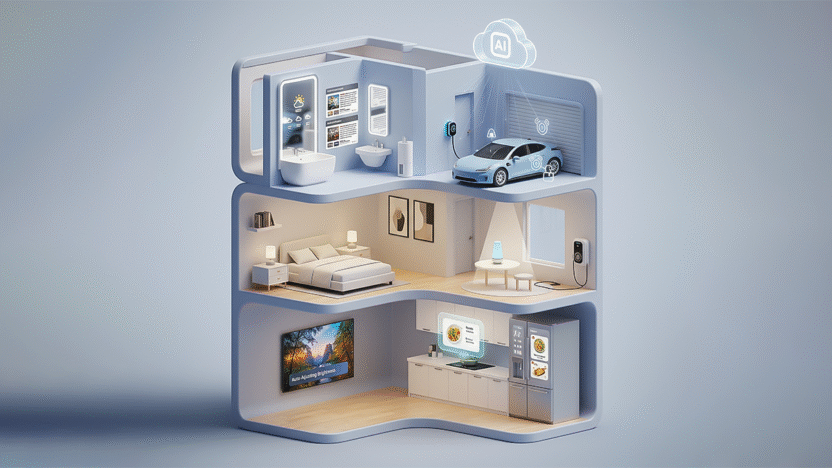AI Smart Home Solutions for Modern Living are revolutionizing the way we interact with our homes. By integrating artificial intelligence with smart devices, these solutions enable homeowners to automate lighting, climate control, security systems, and appliances with ease. AI learns user preferences over time, delivering personalized experiences that enhance convenience, comfort, and energy efficiency.
From voice-controlled assistants to remote monitoring and smart scheduling, these technologies make everyday tasks effortless. Ideal for modern lifestyles, AI-powered homes offer increased safety, lower utility costs, and seamless control through mobile apps or voice commands, empowering residents to live smarter, more connected, and stress-free lives.
Table of Contents:
- Introduction
- Understanding AI in Smart Homes
- Core Components of an AI Smart Home
- Benefits of AI Smart Home Solutions
- Popular AI-Powered Smart Home Devices
- Integration and Interoperability
- Data Privacy and Security Concerns
- The Future of AI in Smart Homes
- Conclusion
1. Introduction
- In an age where technology is seamlessly integrating into every aspect of our lives, the concept of the smart home has rapidly evolved from a futuristic luxury to an accessible, everyday convenience. At the heart of this transformation lies Artificial Intelligence (AI), a powerful force enabling homes to not only be connected but truly intelligent. From adjusting your home’s lighting based on your mood to reminding you to lock the doors or turn off appliances when you leave, AI is redefining how we interact with our living spaces.
- The rise of AI in smart homes reflects a broader shift toward automation, personalization, and convenience in modern living. As consumers seek more efficient, secure, and comfortable lifestyles, smart home solutions have emerged as a natural extension of this demand. No longer confined to isolated smart gadgets, today’s AI-powered systems are deeply integrated, responsive, and capable of learning your preferences over time.
- This blog explores the world of AI smart home solutions: what they are, how they work, the benefits they bring, and why they are becoming an essential part of modern living. Whether you’re just starting to explore smart home technology or looking to upgrade your current setup, understanding the potential of AI can help you create a more connected, intelligent, and effortless home environment.
2. Understanding AI in Smart Homes
Artificial Intelligence (AI) is no longer just a buzzword is a transformative technology reshaping how we live, work, and interact with our surroundings. In the context of smart homes, AI plays a crucial role in enhancing automation, personalization, and efficiency. But what exactly does AI mean when applied to home environments, and how is it different from traditional smart technologies?
What is Artificial Intelligence?
At its core, AI refers to the ability of machines and systems to perform tasks that typically require human intelligence. These tasks include learning from data, understanding natural language, recognizing patterns, and making decisions. In smart homes, AI is embedded within devices or software systems that can analyze user behavior, adapt to changing conditions, and automate tasks with minimal input.
Key AI Technologies in Smart Homes
To enable this level of intelligence, smart homes utilize several core AI technologies:
- Machine Learning (ML): Helps devices learn from usage patterns and improve over time without explicit programming.
- Natural Language Processing (NLP): Allows voice assistants like Alexa, Google Assistant, and Siri to understand and respond to spoken commands.
- Computer Vision: Used in smart security cameras and facial recognition systems to detect motion, identify faces, and differentiate between people, pets, and objects.
- Neural Networks: Mimic the human brain to recognize complex data patterns, often used in advanced voice and image recognition.
AI as the Brain of the Smart Home
Think of AI as the brain of a smart home. While individual devices act as the limbs performing specific tasks, coordinate them to ensure they work together and optimize the overall experience. Whether it’s syncing lights with music, locking doors based on occupancy, or adjusting the thermostat for energy efficiency, AI orchestrates a harmonious and intelligent living space.
3. Core Components of an AI Smart Home
An AI-powered smart home is made up of interconnected devices and systems that communicate with each other, learn user behavior, and automate daily tasks for improved comfort, convenience, and efficiency. Below are the essential elements that form the foundation of a truly intelligent home environment.
1) Smart Hubs and Virtual Assistants
At the center of most AI smart homes is a smart hub or virtual assistant, such as:
- Amazon Alexa
- Google Assistant
- Apple Siri (HomeKit)
- Samsung SmartThings
These AI-driven assistants act as command centers, enabling users to control various devices through voice commands or centralized apps. Beyond simple controls, they use natural language processing (NLP) to understand context, execute routines, and even answer questions or provide suggestions based on past interactions.
2) Smart Lighting and Climate Control
Smart lighting and HVAC systems play a vital role in comfort and energy efficiency. AI enhances these systems by:
- Automatically adjusting brightness based on time of day or occupancy
- Adapting to user preferences and habits
- Integrating with weather data to fine-tune heating, cooling, or ventilation
Devices like Philips Hue lights and Nest Thermostats are popular choices that offer AI-driven automation and remote control via mobile apps or voice.
3) AI-Powered Home Security
Home security is one of the biggest areas where AI has made a significant impact. AI-powered security systems can:
- Detect unusual movement or behavior
- Distinguish between humans, pets, and vehicles
- Send real-time alerts to homeowners
- Use facial recognition to allow or deny access
Popular examples include Ring Doorbell, Arlo, and Deep Sentinel, which combine video surveillance with AI to provide smarter threat detection and response.
4) Smart Appliances
From refrigerators that monitor your grocery stock to ovens that recognize recipes, AI-enabled appliances are changing the way we cook, clean, and manage household chores. Examples include:
- Smart refrigerators with internal cameras and food tracking
- AI washing machines that choose optimal wash cycles
- Robotic vacuum cleaners that map your home and avoid obstacles (e.g., iRobot Roomba, Ecovacs Deebot)
These devices not only add convenience but also help reduce waste and save time.
5) Sensors and IoT Devices
Behind the scenes, smart sensors collect data that feeds into AI systems for real-time decision-making. These include:
- Motion sensors
- Door/window sensors
- Smoke and gas detectors
- Temperature and humidity monitors
The integration of these sensors ensures that your home reacts intelligently to changes, whether it’s turning off lights when no one is in the room or alerting you to abnormal temperature spikes.
4. Benefits of AI Smart Home Solutions
AI smart home solutions go far beyond simple convenience. They offer a wide range of tangible benefits that enhance the quality of life, improve efficiency, and empower homeowners with unprecedented control over their environment.
1) Enhanced Energy Efficiency and Cost Savings
AI-powered smart homes monitor energy usage in real time and adjust operations to minimize waste. Smart thermostats, lights, and appliances learn your habits and preferences to optimize performance, resulting in significant energy savings. For example:
- AI thermostats like Nest can reduce energy bills by learning when to heat or cool the home more efficiently.
- Smart lighting systems automatically turn off lights in unoccupied rooms, lowering electricity costs.
Over time, these small adjustments can lead to noticeable reductions in monthly utility bills.
2) Improved Home Security and Safety
Security is one of the most valued benefits of smart AI homes. AI-based surveillance and alarm systems provide:
- Real-time alerts and video feeds
- Facial recognition for authorized entry
- Automatic threat detection (e.g., package theft, intrusion)
- Integration with emergency services
You can monitor and control your home’s security from anywhere, giving you peace of mind whether you’re at work, on vacation, or just in another room.
3) Personalized Living Experience
AI learns from user behavior, preferences, and feedback to offer tailored experiences. This includes:
- Recommending playlists or shows based on your mood
- Adjusting lighting and ambiance according to your routines
The result is a home that adapts to your lifestyle, rather than the other way around.
4) Remote Access and Control
Whether you’re traveling abroad or simply at the office, AI smart home systems allow remote access to your devices. Through mobile apps and voice assistants, you can:
- Check security camera feeds
- Control appliances
- Receive alerts for unusual activity or system faults
This level of control ensures you’re always connected to your home, no matter where you are.

5. Popular AI-Powered Smart Home Devices
AI-powered smart home devices are becoming more advanced, accessible, and user-friendly, offering homeowners powerful tools to simplify daily routines, improve security, and create more personalized living experiences. With so many devices available today, it can be overwhelming to know where to begin.
1) Smart Speakers & Virtual Assistants
These devices often serve as the control hub for your smart home.
Popular Devices:
- Amazon Echo (Alexa)
- Google Nest Audio
- Apple HomePod (Siri)
Features:
- Voice-activated control of home devices
- Personalized routines and reminders
- Integration with third-party apps and services
2) AI-Driven Thermostats
Smart thermostats adjust heating and cooling based on real-time data and learned preferences.
Popular Devices:
- Google Nest Thermostat
- Ecobee SmartThermostat
Features:
- Learns your temperature preferences
- Uses occupancy sensors to save energy
- Remote access via mobile app
3) Smart Lighting Systems
Lighting systems with AI enhance ambiance, security, and energy efficiency.
Popular Devices:
- Philips Hue
- LIFX Smart Bulbs
- TP-Link Kasa
Features:
- Adjust brightness and color temperature automatically
- Motion-activated and schedule-based lighting
- Integration with voice assistants
4) AI-Powered Security Systems
These systems use advanced technologies like facial recognition, motion tracking, and real-time alerts to provide proactive protection.
Popular Devices:
- Ring Video Doorbell
- Arlo Pro Cameras
- Deep Sentinel AI Security
Features:
- 24/7 monitoring and alerts
- Facial and object recognition
- Integration with smart locks and alarms
5) Smart Appliances
AI-enabled appliances make everyday tasks smarter, faster, and more efficient.
Popular Devices:
- Samsung Family Hub Refrigerator
- LG ThinQ Washing Machines
- Bosch Series Smart Ovens
- Roomba iRobot (Vacuum)
Features:
- Suggest recipes based on available ingredients
- Auto-select optimal settings for laundry or cooking
- Map-based robotic vacuum cleaning
6. Integration and Interoperability
One of the most important aspects of a truly smart home isn’t just owning intelligent devices. Integration and interoperability are key to unlocking the full potential of AI smart home solutions. When devices from different brands and systems communicate with one another efficiently, homeowners experience a smoother, more cohesive, and more responsive environment.
What is Integration in Smart Homes?
Integration refers to the ability of different smart devices and platforms to work together within a central control system. Instead of managing each gadget individually, integration allows you to create unified routines, automate sequences of tasks, and monitor your entire smart home from a single app or voice assistant.
Understanding Interoperability
Interoperability takes integration a step further and ensures that devices made by different manufacturers or using different protocols (like Zigbee, Z-Wave, Wi-Fi, or Bluetooth) can still communicate and function harmoniously. This avoids the frustration of owning incompatible systems that cannot work together.
The rise of universal standards like Matter (developed by Apple, Google, Amazon, and others) is helping to solve this issue by creating a common language for all smart devices to use. Matter-certified devices offer broad compatibility, future-proofing your home setup.
Popular Smart Home Hubs for Integration
Smart home hubs serve as central controllers that bridge different devices and protocols.
Top Hubs:
- Amazon Echo (Alexa)
- Google Nest Hub
- Apple HomeKit (via Apple TV or HomePod)
- Samsung SmartThings
These hubs act like translators, ensuring devices speak the same “language” and coordinate their tasks.
Benefits of Integration and Interoperability
- Streamlined Control: Manage everything from a single app or command.
- Time Efficiency: One routine can control multiple devices simultaneously.
- Scalability: Add new devices over time without worrying about compatibility issues.
Challenges and Considerations
While integration offers significant benefits, it’s important to:
- Ensure your chosen ecosystem supports the devices you want to add.
- Choose devices that are Matter-compatible or work with open APIs.
- Regularly update firmware and apps to maintain compatibility and security.
7. Data Privacy and Security Concerns
As smart homes become increasingly intelligent and interconnected, they also raise serious questions about data privacy and security. AI-powered devices collect and analyze vast amounts of personal data to function effectively, from your voice patterns and daily routines to your location and behavior. While this data enables customization and automation, it also creates new vulnerabilities if not properly managed.
1) The Nature of Data Collected
AI smart home devices rely on data to learn, adapt, and predict your needs. Common types of data collected include:
- Voice commands and recordings (from smart assistants)
- Location and movement data (from sensors and smartphones)
- Device usage patterns (e.g., when you turn on lights or adjust the thermostat)
- Personal information (e.g., contacts, calendar events, preferences)
This data helps AI optimize your home environment but if mishandled, it could expose sensitive details about your life.
2) Best Practices for Protecting Your Smart Home
To enhance privacy and security, homeowners can take proactive steps:
- Use Strong, Unique Passwords: Avoid default settings; use complex passwords and change them regularly.
- Enable Two-Factor Authentication (2FA): Adds an extra layer of security to your accounts.
- Secure Your Wi-Fi Network: Use WPA3 encryption and a separate network for smart devices.
- Regularly Update Firmware: Ensure your devices have the latest security patches and software updates.
- Limit Data Sharing: Adjust settings to restrict how much data your devices collect or share with third parties.
- Choose Reputable Brands: Opt for devices with strong security policies, transparency, and regular support.
3) The Role of Regulation and Transparency
With growing concern over smart home privacy, regulatory bodies are pushing for more transparency:
- GDPR (General Data Protection Regulation) in Europe mandates data access and deletion rights.
- California Consumer Privacy Act (CCPA) gives users control over their personal data in the U.S.
4) Balancing Innovation with Responsibility
AI smart homes offer incredible convenience but with that comes a shared responsibility between manufacturers and users to maintain ethical, secure practices. As AI evolves, so must measures to safeguard digital privacy.
Smart homeowners must stay informed, vigilant, and proactive about data management to enjoy the benefits of AI without compromising their security.
8. The Future of AI in Smart Homes

As artificial intelligence (AI) continues to evolve, the future of smart homes is set to become even more intuitive, autonomous, and personalized. What we see today in voice-controlled lighting, learning about thermostats, AI security systems is just the beginning. The next generation of AI-driven smart home technology will go beyond automation to create environments that can predict, adapt, and even make decisions on behalf of the user.
Let’s explore what lies ahead for AI in smart homes and how it will redefine modern living.
1) Hyper-Personalization Through Contextual Awareness
Future AI systems will understand not just what you do, but why and when you do it. They will analyze contextual cues like mood (through facial recognition or vocal tone), weather, schedules, and real-time data to adjust the environment accordingly.
This hyper-personalization will lead to homes that proactively respond to your emotional and physical needs.
2) Predictive Automation and Decision-Making
Rather than waiting for user input, future smart homes will anticipate needs and take action on their own.
Imagine:
- Your home sensing that you’re low on groceries and automatically placing a delivery order.
- AI managing energy loads across all devices to optimize power consumption and reduce bills.
3) AI Integration with Robotics
Robotics will soon be tightly integrated with AI home systems.
Future Roles:
- Robotic assistants that clean, cook, monitor your health, and provide companionship.
- AI-driven drones or mobile bots handling indoor and outdoor maintenance.
4) Enhanced Interconnectivity with IoT and 6G
The upcoming rollout of 6G networks and more advanced Internet of Things (IoT) frameworks will allow for ultra-fast, ultra-reliable device communication.
Impact:
- Near-zero latency in smart home responses.
- Seamless integration of hundreds of devices and sensors
- Enhanced real-time analytics, automation, and remote-control capabilities.
5) Focus on Sustainability and Green AI
AI in smart homes will also focus on sustainability, leveraging data to:
- Optimize energy usage
- Monitor water consumption
- Suggest eco-friendly behaviors
6) Decentralized AI and Local Processing
To address privacy concerns and latency issues, AI will increasingly move toward edge computing processing data locally within devices instead of sending it to the cloud.
Benefits:
- Faster responses and real-time decision-making
- Improved privacy and data control
- Lower dependence on internet connectivity
9. Conclusion
- AI smart home solutions are no longer just futuristic concepts. From intelligent lighting and climate control to AI-powered security and voice-assisted automation, these innovations are transforming how we interact with our living spaces. By integrating artificial intelligence with everyday devices, homeowners can enjoy enhanced comfort, improved efficiency, greater safety, and a higher quality of life.
- The future of AI in smart homes is incredibly promising. As technology continues to evolve, we can expect homes to become even more responsive, predictive, and empathetic. With advancements in machine learning, IoT integration, and emotional intelligence, smart homes will anticipate needs, reduce manual tasks, and provide proactive support for health, energy savings, and daily routines.
- However, along with the benefits, it’s crucial to remain mindful of challenges such as data privacy and security. Responsible implementation, choosing trusted devices, and maintaining transparency are key to building trust in AI-powered ecosystems.
- In essence, AI smart home solutions offer more than just convenience to create a lifestyle rooted in innovation, adaptability, and sustainability. Whether you’re upgrading your current home or building one from scratch, integrating AI is a forward-thinking investment that prepares your home and your life for the future.




